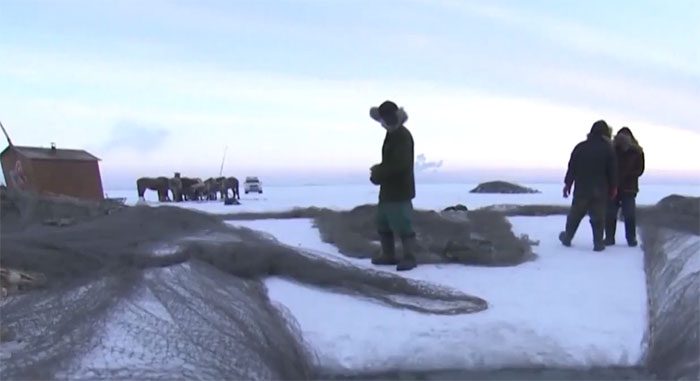Winter fishing activities are in full swing on Chagan Lake, a traditional inland fishing ground in Jilin Province, northeastern China.
Fishermen in Jilin Province fishing under the frozen Chagan Lake. (Video: CCTV+)
Fishermen living by Chagan Lake, which spans 500 km2 – one of the largest freshwater lakes in China – have maintained the tradition of ice fishing for centuries. This activity is recognized as a form of national intangible cultural heritage in China.
As usual, this year’s fishing season began in mid-December when the lake froze to a thickness of about 45 cm and is expected to last until the end of February. Over the past 10 days, fishing teams have conducted large-scale net dropping in the deeper areas of the lake.
Each team typically consists of a leader, a group of fishermen, and several strong horses. The leader is traditionally an older and experienced fisherman. Upon arriving at the lake around 4 AM, the entire team quickly gets to work under the guidance of the team leader.
The ice fishing technique at Chagan consists of four main parts: ice exploration, ice drilling, net dropping, and net retrieval. First, due to the vastness of the lake, fishermen must carefully examine the ice surface to choose the ideal net dropping spot.

This year’s fishing season began in mid-December.
The most common fish in Chagan is the carp. They inhabit the upper layers of the lake and primarily feed on plankton. During winter, after the lake freezes, fish often gather in large schools. These gatherings, when moving, create significant water pressure beneath the ice. Based on this characteristic, along with the color of the ice and sounds from below, experienced fishermen can locate the schools of fish.
The next step is ice drilling. Fishermen measure and drill holes through the ice using specialized equipment. They then begin dropping a large net, 2 km long, through the drilled holes. The final step is net retrieval. The gigantic net is slowly pulled to the surface using a winch and horse power.
To ensure sustainable fishing, fishermen primarily use large mesh nets, allowing smaller fish to escape and continue growing in the lake. Larger fish caught in the nets are harvested and transferred to an “ice yard” covering 10,000 m2. Before the fishing season, fishermen fill the yard with water, and at a temperature of -20°C, the water quickly freezes into a thick layer on the ground, acting as a giant refrigerator to keep the fish fresh.
When this year’s fishing season ends at Chagan, the expected fish yield is 1.5 million kg, an impressive figure that still accounts for less than 1% of the estimated total fish population in the lake. Since 1992, fishermen have released approximately 10 million fry into the lake each year during spring and autumn to compensate for the fish caught.
| The name “Chagan” originates from Mongolian, meaning sacred, pure, or white, so the lake is often referred to by locals as the Sacred Lake or Holy Water Lake. The tradition of winter fishing on Chagan Lake has been ongoing for more than 1,000 years, dating back to the Liao Dynasty (916 – 1125). |


















































